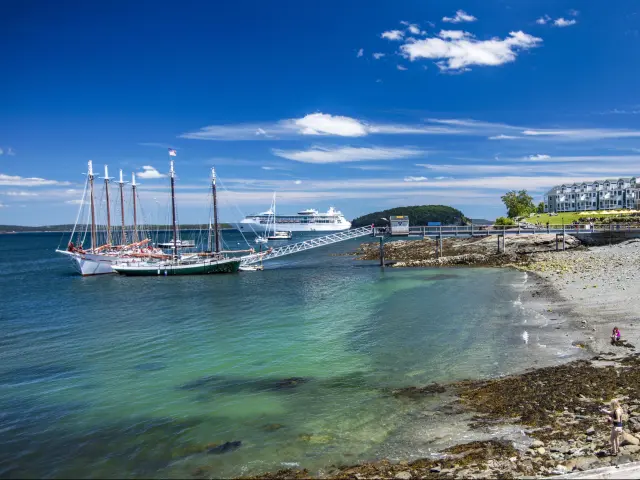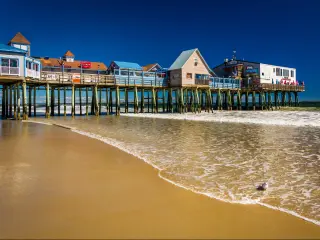Is there a ferry from Boston to Nova Scotia?
Nova Scotia is situated northeast of Boston, on the southeastern tip of Canada. It is a peninsula connected to the province of New Brunswick and mainland Canada. There are several ways to make the journey from Boston to Nova Scotia and the most convenient is to take a ferry.
You can't take a ferry directly from Boston to Nova Scotia. Instead, you can drive from Boston to Bar Harbor and take the ferry to Yarmouth, Nova Scotia - or take a ferry to Digby from Saint John. Another option is to drive from Boston to Nova Scotia.
Continue reading to find out more about how you can travel from Boston to Nova Scotia, with information on alternative travel options and tips on when to travel.
Is there a ferry from Boston to Nova Scotia?
There is no direct ferry from Boston to Nova Scotia, but it is possible to drive from Boston to a nearby port in the US and take a ferry to Nova Scotia. The closest ferry port to Boston for traveling to Nova Scotia is Bar Harbor, Maine, and the ferry journey will take you to Yarmouth, Nova Scotia.
The CAT is a vehicle and passenger ferry that departs daily at 3pm from Bar Harbor, Maine. Making the return journey, the ferry departs from Yarmouth to Bar Harbor daily at 9.30am. This service runs from May to October.
Another option is to drive from Boston to Saint John, New Brunswick and then take the ferry to Digby and sail the Bay of Fundy to reach Nova Scotia. The ferry runs daily year around, except for scheduled maintenance.
Please make sure to check the ferry schedules ahead of time to make sure they are running.
How to reach Nova Scotia from Boston
The most popular route to reach Nova Scotia from Boston is to drive to Bar Harbor and take the ferry. This journey will take around 4 hours and 45 minutes to cover the 280-mile journey.
Alternatively, you can choose to drive directly from Boston to Nova Scotia. Bear in mind that heavy traffic, adverse weather conditions, and roadworks, can impact this estimate, so factor this into your journey time.

How to reach Bar Harbor from Boston
The route from Boston to Bar Harbor is relatively easy, following the interstate for most of the journey. Leaving Boston, take I-95 north and follow the coast before joining I-295. After 100 miles you'll arrive in Portland.
From Portland, continue north on I-295 passing Yarmouth and Brunswick as the route heads inland. After a further 50 miles, you'll be back on I-95 for 85 miles before reaching Bangor.
From Bangor, follow I-395 east for a short distance before taking the US-1A, passing through Branch Lake Public Forest and heading towards Elsworth. Here you'll join ME-3 and cross Mt Dessert Narrows as the road follows the coastline to reach Bar Harbor.
The journey from Boston to the ferry port at Bar Harbor makes for an excellent road trip with spectacular coastal views on offer for much of the way. It is a straightforward route along major roads with excellent opportunities to explore the beautiful Maine coastline
There is an alternative ferry route available from Saint John, New Brunswick to Digby, Nova Scotia. This will involve a long drive from Boston to reach Saint John and a longer ferry crossing than the Bar Harbor to Yarmouth route.
It is possible to fly to Nova Scotia directly from Boston, taking the route directly to Halifax International Airport. The flight time is 1 hour and 30 minutes, and you could consider hiring a car to explore Nova Scotia, but this option will be significantly more expensive than taking the ferry.

How to drive from Boston to Nova Scotia
It is possible to drive to Nova Scotia from Boston. The journey takes you north from Boston to Portland, Maine before passing Brunswick and arriving at Calais's US/Canada border after 330 miles and 5 hours 35 minutes of driving.
From Calais, the route takes you north through Saint John, before crossing the border of New Brunswick into Nova Scotia arriving at Amherst. So, the total distance to drive from Boston to Nova Scotia is 535 miles which will take around 8 hours and 50 minutes.
To drive from Boston to Yarmouth, the ferry port covers 850 miles and takes 13 hours and 35 minutes. Alternatively, if you travel to Halifax, the capital of Nova Scotia, from Boston, the journey will take 10 hours and 50 minutes, covering 670 miles.
How long does it take to reach Nova Scotia from Boston by ferry?
| Option | Ferry Route | Drive Time | Ferry Duration | Total Travel Time |
|---|---|---|---|---|
| Ferry Option A | Bar Harbor-Yarmouth | 4 hours 50 minutes | 3 hours 30 minutes | 8 hours 20 minutes |
| Ferry Option B | Saint John-Digby | 6 hours 30 minutes | 3 hours | 8 hours 30 minutes |
| Driving route (Boston to Halifax) | No ferry | 10 hours 50 minutes | No ferry | 10 hours 50 minutes |
The journey length will depend on where you decide to catch the ferry from, and this can also influence when you decide to make the trip. The ferry crossing from Bar Harbor to Yarmouth takes 3 hours and 30 minutes, and the alternative crossing from Saint John to Digby takes 3 hours.
Bar Harbor is located 280 miles north of Boston and will take 4 hours and 50 minutes to drive. The ferry from Bar Harbor to Yarmouth takes 3 hours and 30 minutes.
Driving from Boston to Saint John will take 6 hours and 30 minutes and cover 410 miles. The ferry crossing from Saint John to Digby, Nova Scotia is 3 hours.
If you allow for driving from Boston and check-in time, then taking the ferry from Bar Harbor to Yarmouth will take 9 hours and 15 minutes, whereas driving from Boston and then ferry from Saint John to Digby will take 13 hours and 45 minutes.
You should allow one hour for check-in for the ferry, and even if you have selected express check-in, you should ensure you arrive in good time.
The ferry from Bar Harbor to Yarmouth only runs in peak season, so if you are planning on making the trip outside of the peak season of May - October, then the ferry from Saint John will be your only available crossing.
How much does it cost to take the ferry to Nova Scotia?
| Departure Point | Arrival Point | Adult Fare | Car Fare |
|---|---|---|---|
| Bar Harbor | Yarmouth | $115 | $200 |
| Saint John | Digby | $43 | $121 |
* Prices shown for the Saint John to Digby route indicate the off-season rates. All prices are shown in CAD, based on a single journey.
Which ferry port should you choose as your destination in Nova Scotia?
The most popular destination is the ferry port at Yarmouth, and the CAT ferry crossing is more protected and offers a smoother journey with less chance of cancellation due to poor weather conditions.

Things you need to know about taking a ferry to Nova Scotia
The fares for the Bar Harbor to Yarmouth ferry are fixed as it only runs in peak season, so allow for this when planning your itinerary.
Here are our top tips when it comes to preparing for a ferry ride to Nova Scotia:
- Check the ferry operator's website for regulations and when to arrive at the terminal.
- Make sure to note when to check in, as these times can change depending on the ferry route you are taking.
- When and how you receive your boarding pass might depend on the specific ferry you are taking, please check ahead of time on the operator's website.
Best time to visit Nova Scotia
Nova Scotia is a beautiful place to visit at any time of year, but the major attractions are more likely to be open, and the weather is much more favorable, in the summer months.
Does the ferry to Nova Scotia run all year round?
The Ferry from Bar Harbor to Yarmouth only runs through the peak season, from May to October, so this is an important factor when planning your trip. The alternative ferry route from Saint John to Digby is operational all year round.
When is the best time to travel to Nova Scotia?
Nova Scotia is one of the warmest regions in Canada and the climate is similar to that of Central Europe. It does have some beautiful summer weather and the best time to visit is between May and October.
July and August are the most popular months for tourists to visit Nova Scotia, and if you choose to make a trip at this time, you won't be alone as around 750,000 visitors will have the same idea. All major attractions will be open and over 80% of the major festivals take place at this time.

In winter the cold season lasts for around 3 and a half months, from early December to mid-March. The average daily high temperature during this period is below 40°F.
The coldest month of the year in Halifax is January, with an average low of 19°F and an average high of 33°F. You can expect an abundance of snow in winter, and it usually snows from late November to early April.
Nova Scotia is home to several mountain ranges, with the whole province situated within the Appalachian Mountains. It has beautiful, lush river valleys, many lakes, and forests, and is surrounded by coastline, a variety of rugged shorelines, and sandy beaches.
There is an abundance of wildlife in Nova Scotia, and it is an excellent place to see Humpback Whales in particular. Whilst they head south to warmer climes in the winter months, they migrate to the area to feed between April and October.
With over 70 species of mammal in Nova Scotia, if you are wildlife spotting on land, then there is a good chance of seeing the black bear, raccoons, northern flying squirrels, porcupines, lynx, and bobcats. Nova Scotia plays host to some fantastic events which might influence when you decide to travel. We recommend checking out:
- Halifax Jazz Festival - an annual event that attracts over 65,000 visitors, taking place over a week in the middle of July. It is one of the largest festivals in Atlantic Canada with over 350 musicians on show.
- Halifax Comedy Fest - Comedians from all over North America hit the stage for the Halifax Comedy Fest with multiple shows taking place across the city. This festival takes place every April, held over 4 days.
- The Celtic Colours International Festival - this takes place over 9 days every October, and this is a festival celebrating Cape Breton Islands traditions and culture with some of the world's best musicians on show with the best local artists.
- The North American Indigenous Games (NAIG) - held in July to help Indigenous athletes come together and realize their potential. The games attract over 5,000 athletes from over 756 Indigenous Nations.
- Gran Fondo Baie Sainte-Marie - the largest cycling event in Nova Scotia. Take to two wheels to explore the area on this amazing coastal ride which takes place in early September. Whilst it attracts serious racers, recreational riders are welcome and it's an excellent way to do some coastal sightseeing.
Things to see once you reach Nova Scotia
There are so many incredible things to see and do in Nova Scotia and it is worth planning a few stopovers in some of the major towns and cities to fully explore them all. Here are a few of our favorite attractions:

- Halifax Citadel National Site - Citadel Hill is a National Historic Site in Halifax, with its strategic hilltop location being chosen in 1749 as an ideal place to protect the city. Step back in time to learn about the life of a Victorian-era soldier.
- Maritime Museum of the Atlantic - Situated in the heart of Halifax's historic waterfront, discover all about Nova Scotia's maritime history and the area's relationship with the sea.
- Halifax Waterfront Boardwalk - Visit one of the world's longest boardwalks, a lovely walk in itself, and the bustling hub of the city, home to many of its best restaurants and shops.
- Peggy's Cove - One of Nova Scotia's most popular attractions, a beautiful fishing village with the iconic Peggy's Point Lighthouse, standing on 400 million-year-old granite, a spectacular sight.
- Canadian Museum of Immigration at Pier 21 - Learn how the influx of migrants in the 20th century helped to shape the country. Situated in Halifax, where almost 1 million immigrants arrived in Canada between 1928 - 1971.
- Halifax Public Gardens - Take a stroll around the Victorian-era-inspired gardens, with 16 acres of ever-evolving horticulture.
- Cabot Trail - Drive the coastal route around Cape Breton Island, regarded as one of the best road trips in the world for its mesmeric scenery.
- The Big Fiddle - Visit the world's largest fiddle in Sydney, Cape Breton. Made of solid steel, this giant fiddle and bow is 60 feet high and was designed as a tribute to the region's Celtic folk traditions
- Cape Breton Highlands National Park - Witness spectacular panoramic views and explore the many scenic trails, where the mountains meet the sea in this beautiful wilderness.
- Inverness Beach Boardwalk - Take a stroll along the 1.5km sandy beach and enjoy the warm shallow waters and soft golden sand between your toes in this truly stunning location.
- Victoria Park - Enjoy this natural woodland park spanning over 3,000 acres, with its gorges, waterfalls, and extensive trail system located close to downtown Truro.
- Truro Tidal Bore viewing/visitor centre - Fundy discovery site is home to an incredible tidal phenomenon, with some of the highest tides on earth, occurring twice daily. The visitor centre is a fun place to learn all about this amazing natural display.
- Marigold Cultural Centre, Truro - The place to go for arts and culture in the community, with concerts, classes, and exhibitions in the gallery.
- Colchester Historeum - Discover an authentic perspective on the local history and culture, with an impressive display of exhibits and artifacts. Visit the historeum shop for a unique souvenir.
- Lunenburg - Known as the prettiest town in Canada and also a UNESCO World Heritage Site, visit the picturesque painted houses on the waterfront.
Whilst it isn't possible to take a ferry directly from Boston to Nova Scotia, it is worth the drive to catch the ferry as this stunning province surrounded by ocean is one of the ultimate road trip destinations with the Cabot Trail being one of the most scenic drives in the world.
With its rich culture and traditions, endless seacoast and some of the friendliest people on earth, a trip to Nova Scotia should be at the top of your bucket list.










